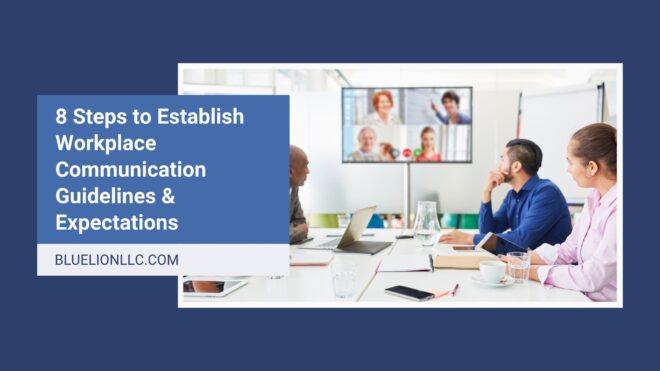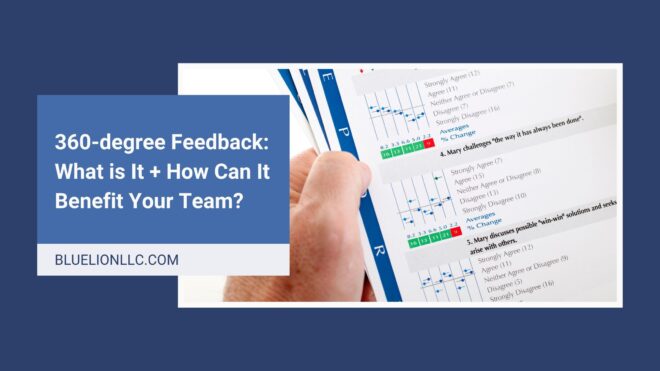
In the complex world of workplace dynamics, communication is a crucial factor, guiding collaboration, progress and productivity, and harmonious relationships. But crafting effective workplace communication guidelines isn’t just about finding the right words; it’s about understanding the pulse of your organization, the needs of your teams, and the pathways to clarity and connection.
Have you ever established communication expectations? Perhaps you have, but it’s been a while since you revisited them or shared them with your employees. Or maybe you haven’t yet, but your team is growing, and it’s time to streamline your processes.
Wherever you’re at, follow these seven steps to put these important guidelines in place.
1. Evaluate Your Workplace Communication Needs
Before you begin developing or updating workplace communication guidelines, assess your current communication practices, channels, and tools. Gather your leadership team and start by asking:
- Are you managing an in-person, hybrid, multi-location, or remote workforce?
- Where are there gaps? What are the pain points?
- Who are the audiences/stakeholders?
- How do you measure the effectiveness of your communication? Is it effective?
- Do you have a crisis communication plan?
It’s also a good time to ask your employees for their feedback on existing workplace communication techniques. You could do this in a few ways, such as one-on-ones with managers, department meetings, or employee surveys.
Then, find the common themes (i.e., concerns, breakdowns, bottlenecks, etc.) and focus on strengthening those areas throughout the rest of this process.
2. Set Internal Communication Goals
Once you’ve assessed your business’s strengths and weaknesses regarding internal communications, it’s time to establish a broad strategy. This should account for everything from everyday information and announcements to significant political and societal issues, which have been on the rise in recent years. Include guidelines for leaders to spread key messages and recognize employees who go above and beyond.
Additionally, include steps for communicating essential updates with the internal team before broadcasting them elsewhere—letting employees hear major announcements via social media, online, or the news can be a major morale killer. Instead, make team members feel valued by communicating all news, good and bad, with them before the public. This portion should also include guidelines for what employees can or can’t do with the information and how it affects them and the overall business.
Ensuring your employees are aligned with your goals will not only maintain a transparent, respectful corporate culture but also create a consistent, clear customer experience. However, not aligning your team could lead to miscommunication, poor customer experience, and potential backlash.
3. Create Style & Tone Guidelines
If you have brand guidelines, they could be a great starting point for establishing workplace communication expectations—in fact, the two should work hand in hand. While we’re specifically addressing internal communication here, consider how you want to communicate with your external stakeholders (e.g., customers and partners). Your tone and style should be consistent from the inside out, which comes back to your employees.
Of course, the tone of internal workplace communication may vary depending on the purpose and context. As LinkedIn notes, your official documents and reports may call for a formal and professional style, while you allow a more casual, friendly tone for social media and newsletters.
4. Select Communication Methods & Channels
Include guidelines for both written and verbal workplace communication methods. Similar to tone and style, this depends on the purpose, goals, and audience of the message. Examples include:
- Posting official announcements, policies, or procedures (format) to the company intranet (channel), where these crucial resources can live permanently for employees to easily access.
- Compiling important data and detailed information in a report (format) and sending it via email (channel) with an outline, context, and action steps
- Presenting (format) a new service or product via a virtual or in-person demo (channel) to educate your employees live and invite questions or feedback
Outline tips for when and how to use specific workplace communication tools and apps. Consider what format and channel will make it easiest to digest and remember the message at hand. For example, in one study, 48% of workers said video is the most engaging form of communication—are there ways you can incorporate video more?
You might also note when a meeting is necessary vs. when an update could simply be shared via your project management tool, chat, or email.
5. Make Communication Integrative & Inclusive
As you choose your organization’s primary communication tools and purposes for each, you should also determine when asynchronous vs. synchronous communication should be used.
Asynchronous communication refers to methods where participants don’t need to be present or engage in real-time interaction. Instead, messages or information are exchanged without the need for immediate response, thus allowing:
- Employees to engage with messages or content when it’s convenient for them, regardless of the sender’s availability
- Individuals to focus on other tasks before responding thanks to fewer interruptions during the workday
- Easy collaboration across different time zones and geographical locations—making it ideal for remote and multi-location businesses
- Well-documented communication for later reference (since asynchronous communication typically involves messages that are saved)
Team members can send non-urgent messages via asynchronous channels like your project management platform (e.g., Asana), messaging apps (e.g., Teams or Slack), or email.
When you have time-sensitive information, you might leverage synchronous (i.e., real-time) methods like Zoom meetings, phone calls, or messaging apps, which can be used for both types of communication.
Taking a multi-channel approach to workplace communication ensures employees are included in relevant discussions and decisions, thus making them feel included and valued. In turn, this will boost employee engagement. Proactive, inclusive communication is particularly important with the shift to hybrid and virtual teams over the last few years.
6. Set Employee Expectations
Next, it’s time to set employee workplace communication expectations. These should outline:
- Frequency for checking each communication channel
- Acceptable response times,
- Updating their calendars and out-of-office (OOO) messages
- How much notice employees should give for rescheduling meetings
Define these expectations clearly—if you say respond in a timely manner, outline what that means for each channel.
For example, social media scheduling tool, Buffer, notes that employees are expected to respond to Slack messages by the end of their workday, Threads within two days if you’re tagged or a week if not, and within two days for all other methods.
Your guidelines should also set standards for CLEAR communication and good writing practices (e.g., proper grammar, spelling, punctuation, formatting, etc.). Remind people to provide sufficient background information and context and monitor their tone. This is harder to convey in written workplace communication, so rereading and proofreading our content is vital.
However, the same goes for verbal communication—we can get carried away with emotions, so when things get stressful or heated, it’s easy to let that seep into our speech. We need to think carefully about our tone and words before speaking.
7. Consider Timing
We’re all inundated with messages and information daily. In fact, one study found that 80% of global workers experience information overload, while 76% felt that it contributes to increased workplace stress. This is why you’ll also want to provide guidelines on how and when employees should communicate.
Thoughtful, effective leadership also includes careful consideration about the timing and frequency of sending messages and sharing information. They set the standard for healthy workplace communication practices (e.g., setting boundaries and expectations about when messages should be sent and responses). Avoid creating a toxic workplace culture by calling, emailing, and texting employees at all hours—which puts pressure on employees to always be available.
Ensure your workplace communication policies define what it means to respect one another’s time, such as contacting coworkers outside regular working hours and giving people sufficient time to respond. For example, if certain colleagues like to email in the evening, they might include a line in their signature noting there is no pressure to respond immediately.
8. Share Workplace Communication Guidelines
Once you establish workplace communication guidelines and policies, it’s time to—you guessed it—communicate them with your team! A few places they should live include the employee handbook and company intranet.
Additionally, you can share communication expectations by:
- Conducting workshops
- Sending it regularly in internal newsletters
- Incorporating it into the new hire orientation process
When you first share your workplace communication guidelines, you might accompany them with a video introduction (this works well when sharing via intranet or email). This video could outline the key elements, like style, tone, audience, and methods/formats, as discussed earlier.
Finally, don’t hesitate to ask for feedback. Your employees may have valuable insights and ideas to continue improving communication practices. After all, different roles and departments may have different needs, challenges, or perspectives.
Prioritize Workplace Communication, Strengthen Your Team
In the ever-evolving landscape of business, effective communication is more than a tool—it’s the cornerstone of collaboration, innovation, and organizational harmony. By embracing the principles outlined here, you’re not just setting guidelines; you’re fostering a culture where all employees know they’ll be heard, ideas flourish, and connections thrive.
So as you navigate the cadence of workplace communication, remember it largely comes down to how every message is shared, heard, and understood throughout your business!
Need tailored guidance as you develop employee communication guidelines and expectations? Our HR consultants love helping small business owners and leaders level up areas of their corporate culture like this! Contact BlueLion today at info@bluelionllc.com or 603-818-4131 to learn more.
The information on this website, including its newsletters, is not, nor is it intended to be legal advice. You should contact an attorney or HR specialist for advice on your individual situation.












